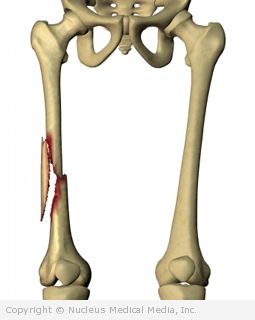Femoral fracture
(Femur Fracture; Thigh Bone Fracture; Broken Leg)
Femoral fracture – Definition
A femoral fracture is a break in the thigh bone, which is called the femur. The femur bone is also known as the thigh bone. It runs from the hip to the knee and is the longest and strongest bone in the body. It usually requires a great deal of force to break the femur.
Femoral fracture – Causes
A femoral fracture is usually caused by direct trauma to the bone. Trauma includes:
- Falls
- Blows
- Collisions
- Severe twists
Femoral fracture – Risk Factors
A risk factor is something that increases your chance of getting a femoral fracture. Tell your doctor if you have any of these risk factors:
- Advancing age
- Postmenopausal osteoporosis
- Decreased muscle mass
- Certain diseases that weaken bones, such as osteoporosis or cancer
- Participation in certain contact sports, such as football
Femoral fracture – Symptoms
Symptoms include:
- Immediate and severe pain
- Swelling and bruising around the area of the break
- Inability to walk and/or limited range of motion of the knee or hip
- Deformity of the leg, such as shortening or abnormal twisting of the injured leg
Femoral fracture – Diagnosis
The doctor will ask about your symptoms, physical activity, and how the injury occurred. The injured area will also be examined. You may have x-rays to look for a break in the bone.
Femoral fracture – Treatment
Treatment will depend on the location and severity of the injury. Treatment involves:
- Putting the pieces of the bone back in position, which may require anesthesia and/or surgery
- Keeping the pieces together while the bone heals
Devices that may be used to hold the bone in place while it heals include:
- A cast (rarely used except in very young patients)
- A metal plate with screws (requires surgery)
- A rod down the middle of the bone (requires surgery)
- Metal pins that cross the bone, with a frame on the outside of the leg that holds the pins and the fractured bone in place (requires either general or local anesthesia)
Your doctor will order additional x-rays while the bone heals. This is to ensure that the bones have not shifted position.
Once home, follow your doctor’s discharge instructions.
Exercises
When your doctor decides you are ready, you’ll start range-of-motion and strengthening exercises. You may be referred to a physical therapist to assist you. Do not return to sports until your leg is fully healed and your thigh muscle strength is back to normal.
Healing Time
A fractured femur is a serious injury that takes 3-6 months to heal.
Femoral fracture – Prevention
To help prevent femur fractures:
- Do not put yourself at risk for trauma to the femur.
- Eat a diet rich in calcium and vitamin D.
- Build strong muscles to prevent falls and to stay active and agile.
- Always wear a seatbelt when driving or riding in a car.
- Wear proper padding and safety equipment when participating in sports or activities.
- Femoral fracture has been linked to osteoporosis (thinned bones) in people over age 55. Be sure to find out whether you have osteoporosis. Follow any treatment recommendations for this condition to help prevent further fractures.

